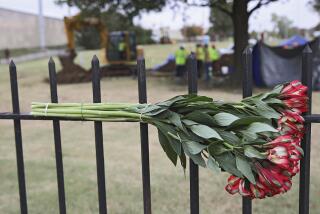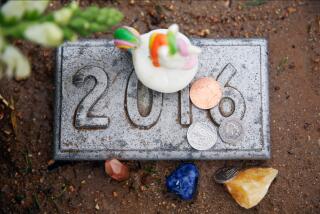Serving life at the altar of death
Not long after she began studying to become a mortician, Amber Carvaly started to dream about death.
In one dream, she found herself in an embalming room surrounded by gleaming silver tables. In another, she found herself in a cemetery, and in a third, her grandmother had died and, as her mother stood by, Carvaly let out an ear-piercing, heart-wrenching scream.
Each time she awoke in her studio apartment in Eagle Rock scared, yet strangely reassured. Weeks into a demanding curriculum on such topics as the cultural history of undertaking, preparation for embalming and funeral ceremonies, she hadn’t grown numb.
Carvaly, 27, has experienced her share of loss — a great-grandmother, a cousin who took his life, an uncle who died in a car crash, fathers of friends in high school — nothing inordinate but meaningful nonetheless, and she is afraid of what lies beyond the last breath.
But fear is what drives her. Somewhere amid the smell of formaldehyde, the sweet taste of energy drinks and pages of anatomy, accounting, counseling and law, she is searching for a profession and an identity that will transcend the ephemera of daily life and show her how to live undaunted by mortality. She believes she has found it.
“There is something beautiful about being part of the ritual of death, performing the most ancient of jobs,” Carvaly says, “and the possibility of serving my life this way is the motivation for the days when I just want to lay my head on my desk and cry from stress.”
Commuting nearly 80 miles each day, to and from Cypress College in Orange County, she works evenings waiting tables to help pay for school, and she studies well past midnight — all for the chance to work in a field known for its long hours and low pay, on average starting at $31,000 a year.
Carvaly has a bachelor’s degree in women’s studies from UC Riverside, was a make-up artist in Hollywood and worked with the homeless at a Los Angeles nonprofit. She considered becoming a nurse but found the schools too crowded to get the classes she needed. She wanted to do something noble and remembered a friend who learned undertaking in the Navy and had found a job at a mortuary in Corona.
She listened to his stories about going to the morgue, setting up for a service, picking up the deceased — babies from families, husbands from wives — and she was amazed that someone her age could do this work.
Classes started in August and are designed to give students an edge when they take the state and national licensing exams. If Carvaly graduates in three semesters, she will have paid a little more than $5,000 to learn how to embalm and to arrange a funeral. Some have called the profession “the dismal trade,” but she sees nothing dismal about it.
“We can’t appreciate life without appreciating death,” she says. “I want to help people realize this.”
Diverse curriculum
On a Tuesday morning, Carvaly joins her study group — Chris Folger, Nina Mendoza and Theresa Wenning — in the Mortuary Science School’s library. Their first anatomy exam begins in less than two hours, and they need to drill.
On a wall above them hangs a black-and-white photograph of a young man with wavy hair and Poindexter glasses. He was one of the first students of the school in 1929 when it was in Boyle Heights and primarily taught embalming. Today the accredited curriculum, one of only two in California, is more diverse, and the mortuary program has an enrollment of nearly 125.
“What are the four tissues of the body?” Folger asks.
“Why do you hate me so early in the morning?” Wenning says.
The four met the first week of class and realized they had a better chance making it through the next 18 months if they worked together. They have grown close, gathering before and after classes, calling one another at night with questions and encouragement. The women tease Folger as they might a brother.
Carvaly’s other friends don’t understand. They think undertaking is all about handling dead bodies and selling caskets and headstones. She might as well carry a scythe, and when they say they don’t fear death, she hears in their voices an apathy that saddens her.
Her professors had warned her. “After a while,” Jolena Grande says, “many of your old friends will magically disappear.”
Grande, who has been teaching at Cypress since 1995, has been in the funeral industry since 1989. “I cannot begin to describe the number of people who are disgusted with my chosen occupation and my ‘sunny’ outlook on death,” she says. “I suppose we are all supposed to shun death and fear its place in our lives.”
Students say they came to this school to be of service, but beyond the altruism lie deeper currents: a fascination with human anatomy, a pride in performing a task others find repulsive, a chance to work where emotions are often so keen and a delight in the cocktail-party shock factor. You do what? What’s that like?
The rigors of the program — between 15 and 18 hours in the classroom and about 30 hours or more studying each week — are designed to initiate the students into the challenges of the profession, as well as cull curiosity seekers.
Grande has another theory for why students enroll. “I think many people enter funeral service in a quest for answers to their own unresolved grief,” she says.
Grief came at early age to Wenning, 48. She still remembers the policeman who visited her family to inform them that her father had been killed in a traffic accident. She was 10, and, during the visitation at the funeral home, wondered why dad had such heavy make-up on his face and wore a turtle-neck.
Folger, 26, lost his grandmother when he was in high school. He had taken care of her after her strokes, and he didn’t attend her funeral. He loved his Grandma Evelyn but couldn’t bring himself to say goodbye. Six years after her death, he picked up a phone book and applied for an entry-level job at a mortuary.
Mendoza, 39, encountered grief at the convalescent home where she worked as a licensed vocational nurse. She grew close to her patients and remembers Bebe, whom she considered a grandmother, well after she died.
Carvaly can’t say whether her losses have been resolved. Death has always caught her eye: Forest Lawn, off the Ventura Freeway, looking so beautiful and peaceful; her artwork with its dark anime styling.
In one painting she depicts a couple holding onto each other; beside them, she has written: “Death pulled her close into his arms and sang his sweet refrain, ‘Remember what I told you doll, We live a life of pain.’”
Pragmatic lessons
Room 222 is like any other college classroom: concrete walls, stained ceiling tiles, a mouse-gray carpet and more than 60 desks arranged in narrow rows. Glenn Bower pushes open an accordion screen and rolls to the front of the room a metal casket, painted autumn gold.
“So,” he asks, “how many of you have familiarity with a Catholic funeral?”
Out of nearly 40 students, a few hands rise, and Bower, 44, director of the mortuary science program, begins his lecture on the funeral Mass with a few props: vigil candles, a Paschal candle, an altar, a kneeler and the casket.
The lessons are often pragmatic. Undertaking is a trade, and this is a vocational school. Students learn different ceremonies — religious and secular — and are taught a language of gestures and niceties meant to cast a consoling light upon loss.
As Bower introduces the prie dieu, or kneeler, he walks over to the small upholstered bench in the front of the room.
“Notice how it’s 45 degrees to the casket?” he asks. “This allows the person who’s praying to view the deceased.”
Carvaly rests her head in the crook of her left arm and takes notes with a black pen, a pink pen and occasionally a yellow highlighter.
The rituals fascinate her: where to place flowers during a visitation (immediate family’s closest), what to say to clients over the phone (avoid “thank you”; gratitude seems insensitive), how to explain death to children (don’t call it going to sleep).
She looks forward to learning how to embalm. When she describes the methodical process — the cleaning of the body, the massaging of the fluid into the tissues and extremities — she imagines a reflective quality to the work.
Death, she believes, is a time to slow down; funerals are about making people stop to think about life. “At a time when you can bury grandma with a 16-digit credit card number, I think that’s terrible,” she says.
Life and death
On a Sunday afternoon, Carvaly leaves her rental and her two cats for a coffee house in Silver Lake, where she can sip an iced mocha and listen to Florence and the Machine on her iPod.
She spreads out her books and takes a moment to imagine the conversations around her, the latest releases, tonight’s parties. She once had those concerns. Now she lives in another world, where death is part of everyday life.
She studies cell degeneration, gangrene and congenital disease until she can memorize no more. She needs to get to an art store before it closes. She wants to pick up some black ribbon that will cover the words that circle her wrist. Funeral directors are not supposed to show any ink.
“This too shall pass,” it says, the wisdom of Solomon that has helped her through the years.
She hopes someday to get new writing and is thinking of a line from a poem sometimes etched inside church bells. Vivos voco. Mortuos plango.
I call the living. I mourn the dead.
More to Read
Start your day right
Sign up for Essential California for news, features and recommendations from the L.A. Times and beyond in your inbox six days a week.
You may occasionally receive promotional content from the Los Angeles Times.







